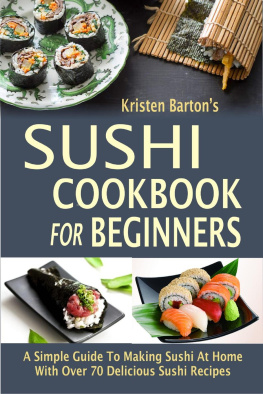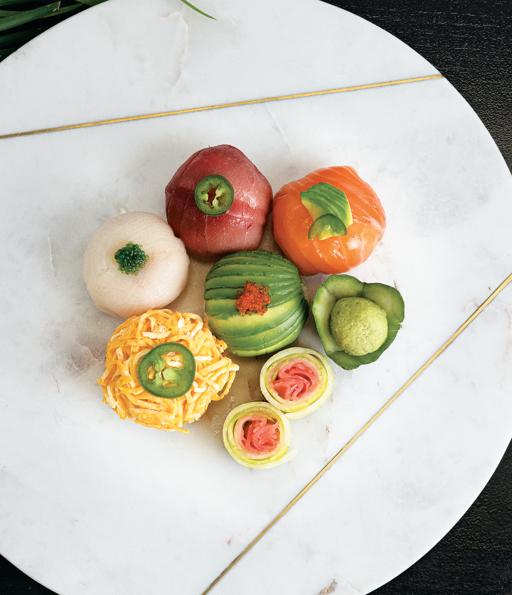FOREWORD
Sushi is one of the toughest Asian cuisines to learn because it has almost no relation to other foods most folks make. A lot of other cuisines can be guessed at or contextualized. Stir fry is just saut with a few new ingredients. Salads are vegetable medleys with a dressing for the most part, and even the dressings are a combination of an oil, an acid then some flavorings and seasonings. Cooks can usually use the rules in their repertoire to extrapolate a dish, even if it is foreign; there are some small parts to latch onto that are somewhat familiar. But not for sushi. Sushi is a delicious, strange new world that has no road maps cooks can identify or start to make sense of. So, writing a cookbook on sushi is even tougher than most subjects. Luckily, you are in the hands of a great chef and guide in these pages.
Ive known Chef Andy for over 20 years. When I was in my twenties, I had a firm grasp on cooking Thai and Chinese cuisines from growing up in those cultures. I had more than my 10,000 hours thanks to my familys three generations of restaurant, shopkeeping and farming experience. But I was always fascinated by sushi and Japanese cuisine. Through the context I had with my Chinese, Thai and French cooking background, I did my best to figure out how to make my favorite sushi and sashimi dishes for years. But even with my extensive experience, I was only guessing. It really took expert guidance and training from Chef Andy to give me the deep, knowledgeable push that opened up the world of sushi to me and really shaped my career.
I trained under Chef Andy for a time and learned the building blocks of making sushi. He taught me the fundamentals of making sushi rice and sushi vinegar, and how critical it was for both to be prepared perfectly. Then we moved on to fish selection and preparation, and continued on to mastering the dressing, sauces and finally, the plated sushi and sashimi. Chef Andy always patiently shared his secrets and wove in the history and stories behind this cuisine into my lessons, which caused me to foster a deeper and more meaningful connection to this traditional food. This is what this book will do for you. It will teach and guide you through into this new, fascinating world and hopefully change you forever.
Happy Cooking!
JET TILA
INTRODUCTION
Hello! My name is Andy Matsuda. After working as a sushi chef for many years, I decided to open the Sushi Chef Institute 20 years ago with the hopes of bringing professional chefs, and anybody who wanted to learn about it, closer to Japanese cuisine. I am excited to now share some of my knowledge in this book. The following pages describe the basic techniques and preparations for making traditional sushi in Japanese food culture. It is said that the sushi boom began in America about 50 years ago; since then, its become a nonstop industry that continues to grow. In 1981, when I came to the United States, I could see the sushi boom very much alive among the people eating in Santa Monica sushi bars and not only in Little Tokyo, but in downtown Los Angeles where it all started. This phenomenon continued to expand even more across the West Coast after the 1984 Los Angeles Olympics, and Japanese food culture started to prosper all over the world.
In the Western food scene, instead of Japanese edomae sushi, which is mostly simple sushi rolls, and hako zushi (pressed sushi), which uses fresh, raw and sometimes cooked or cured fish and seafood, special locally inspired rolls, such as , became a major trend and opened the doors even more for Japanese cuisine in Western culture. Now, we are entering an era in which people from different cultural backgrounds have incorporated sushi into their diet often, from once or twice a month to every week! In that sense, I was inspired by the sushi roll culture, which sparked the sushi boom here in the United States, to share my knowledge in this book so that as many people as possible can feel closer to the Japanese cuisine they love.
This book will teach you to easily make sushi at home. It is for those who have never made or eaten homemade sushi. My goal is to share with you an attainable and simple way to bring sushi to your table. Ill share my simple techniques for making sushi rolls, nigiri and sashimi. Hopefully, youll be able to incorporate new healthy meals into your diet and enjoy a fun activity that you can share with your family and friends, that brings you closer to each other in the process. My hope is that, with this book, children who have grown up with Japanese anime and manga will become closer to Japanese food culture, and maybe become their own artistic sushi chef.
With this book, I aim to expand your knowledge of sushi and the many forms it takes today, from raw fish to cooked fish and vegetables. Ill show you how sushi can become a part of your healthy diet. There are endless possibilities with this cuisine. I will take you step by step through my techniques so you can bring this piece of Japanese culture into your home. If some of the ingredients are not available in your area, you can always create your own sushi rolls with the products your local market has to offer.
Yarimashoo! (Lets get to it!)

THE ESSENTIAL TOOLS & INGREDIENTS
Before going into more detail about the modern tools you will be using, I want to share a story. My first sushi tool was a yanagi knife. It was a gift from my master, and I still have it. In the beginning, I had no idea how to maintain the knife and I messed up a few times. But I didnt give up and kept sharpening the knife for a long time. I have many fond memories with my first knife. It was the only knife I brought with me to the United States in 1981; we became immigrants together. I hope you can make beautiful memories with your sushi tools, too!














